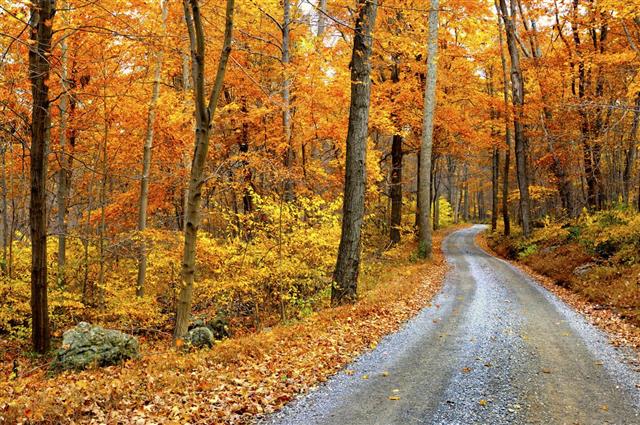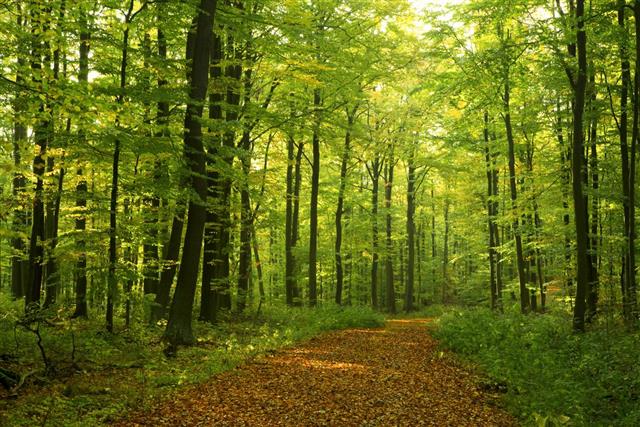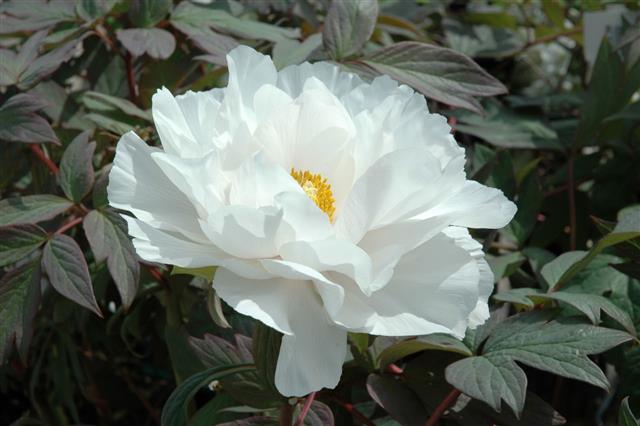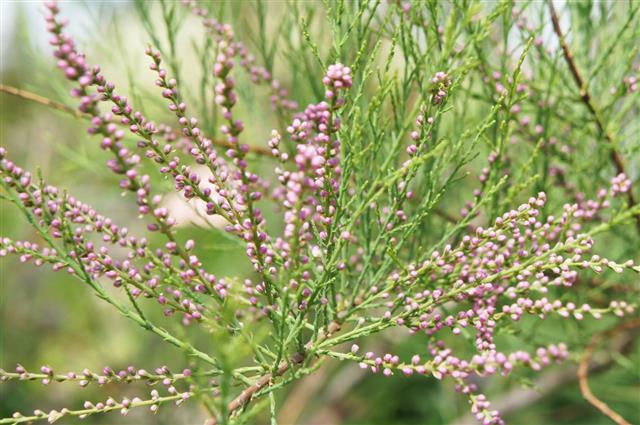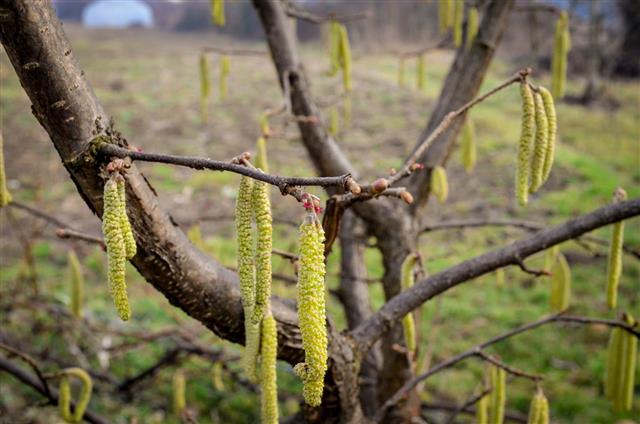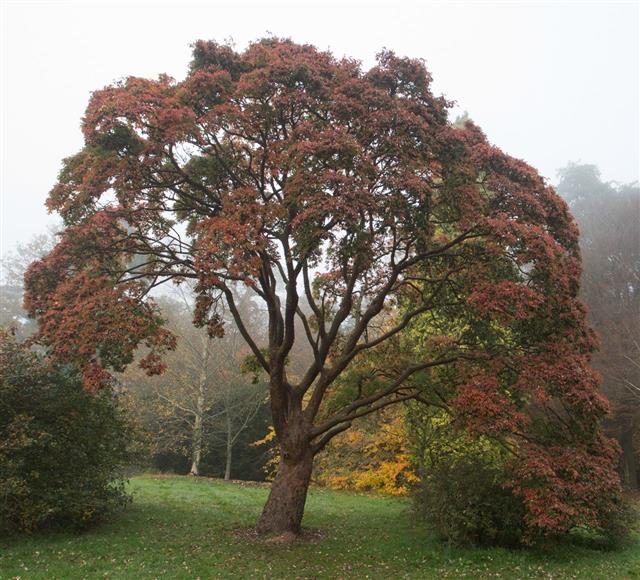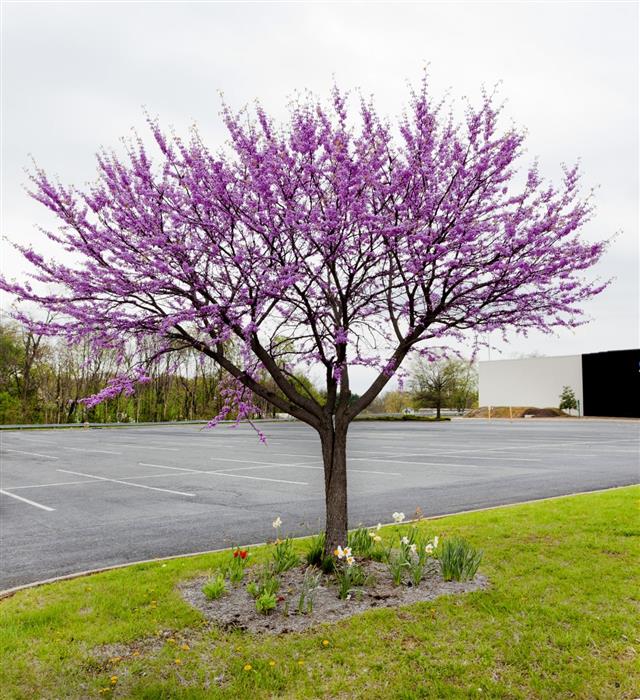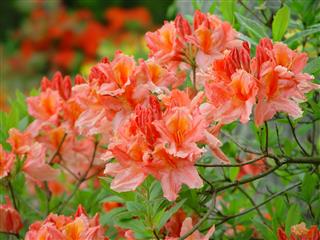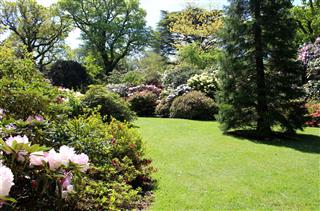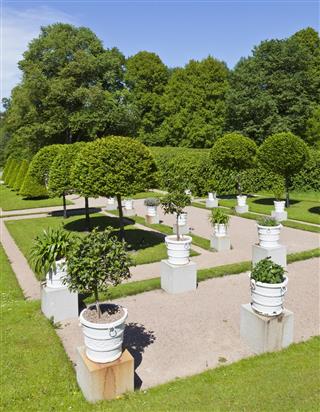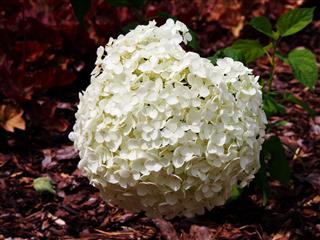
The Earth is covered with many types of vegetation, from evergreen forests to desert vegetation. However, it is the deciduous forest plants that mesmerize us with their ever-changing hues and growth pattern. Let us learn more about these enchanting forest plants.
The name deciduous is taken from the Latin word decidere, which means to fall off. This term is used for describing trees that shed their leaves during a specific season. The leaves change their color and fall in autumn, and regrow when spring arrives. These plants become dormant in winter and bloom again in spring.
Following are some of the shrubs and trees found in deciduous forests across the globe. These plants can be used for ornamental purposes in gardens and for professional landscaping.
List of Deciduous Shrubs
Hydrangea

The color of the flowers is affected by the pH level in the soil. Soil with lower than 6.0 pH will produce bluish flowers, while pH greater than 6.0 will produce pink flowers. This plant requires plenty of sunlight and moist soil to thrive, however it must be placed in a partially shaded part of the garden so as to avoid excess exposure to sunlight.
Azalea

The Azalea plant must be placed in a relatively shaded area and must be provided plenty of moisture. The plant has both ground covering as well as tall varieties, which can attain heights of 25 feet. The plant must be pruned as soon as the blooms wither and before it is time for the next budding season. Azalea flowers are bell-shaped or tubular and can display various colors such as, white, yellow, red, pink, and purple.
Butterfly Bush

This shrub grows well in hardiness zones ranging from 5-10. It requires full sun and is adaptable to various types of soil, as long as it is well-drained. The flowers bloom during summer and fall. It has a capsular fruit which is inedible for humans. The Butterfly bush is also susceptible to fungal infections and pest.
Bailey Compact

This shrub requires partial shade, medium moisture, and well-drained soil. The shrub is known for its bright red fruits and pretty white flowers, which is why it is preferred as a screen shrub because it accentuates the beauty of the garden. Strangely, birds and other animals do not prefer the fruit of this shrub.
Common Lilac

This shrub grows better in well-drained soil and cannot tolerate excess moisture. Since this plant is native to rocky areas, it does well in elevated terrain. Even though it prefers alkaline soil, this shrub grows well in neutral soil as well.
Common Chokecherry

Its leaves turn purple with the coming of summer, which makes this shrub an attractive addition to the garden. This shrub thrives in soil which has a pH between 5.0-8.0 and is adapted to various types of soil, thereby making it comparatively easy to grow and replant.
Double Flowering Plum

The shrub has ornamental features and yields flowers which resemble rosebuds. Once the flowers bloom, they cover the entire line of the branch, thereby making the shrub look completely pink, with a few specks of green scattered all over the plant. Once the flowers wither, the foliage turns to crimson gold with bronzed branches.
Pussywillow

This shrub is native to wetlands and thus requires plenty of water to thrive. These shrubs are suitable for terrain that are wet and poorly drained. The male plant matures faster than the female, and produces yellowish catkins as compared to the grayish-white ones produced by the female plant.
Tamarix
Tamarix or salt cedar is a deciduous flowering plant, which is native to the arid areas of Africa and Israel. This shrub can grow up to 16 feet and has flowers which are whitish-pink. The flowers bloom for a long time and can be seen from January to mid-September. This shrub is hardy in zones between 3-9.
The Tamarix requires full sun or partial shade and plenty of water. Nonetheless, it tolerate dry sites, alkaline soil, saline soil, and windy terrain with exceptional ease. This shrub is considered invasive because it spreads rapidly, invades wetlands, and makes the soil more saline. It also deprives other vegetation of water, thereby making it hard for anything else to grow.
Alpine Currant

The hardiness zones for this plant is between 3-7. This plant thrives in soil which is less alkaline, well-drained, and moist. The Alpine currant requires partial sunlight to grow comfortably. It yields red fruits during midsummer which are edible but lack flavor and are unpalatable. The foliage of this shrub is dense and remains throughout summer. It is also resistant to many diseases.
Japanese Barberry

Wayfaring Tree

Magnolia Stellata

Ash Leaf Spirea

Also known as ‘Sorbaria sorbifolia’, the Ash Leaf Spirea is a dense shrub. It grows well in USDA hardiness zones ranging from 4-7. This shrub can grow to a height of 4 feet and has a spread of 5 feet. It requires partial shade, sun, ample moisture, and soil that is well-drained. It also yields beautiful clusters of white flowers which bloom during June and July.
Bumald Spirea

This Bumald Spirea shrub grows in USDA hardiness zones ranging from 4-8. It’s height and width extend to 5 feet. It requires full sun and moist soil with neutral pH levels to grow properly. The flowers bloom during midsummer and can be of white, pink, and red shades. The foliage remains yellowish-green during spring and summer, and then turns to purplish-bronze during autumn. Some hybrids in this species have purplish-blue foliage as well, such as the Anthony Waterer variety.
Buffaloberry

The Shepherdia argentea or the Baffaloberry is native to the North American plains. It grows well in hardiness zones between 3-9. This shrub has dwarf varieties which grow up to 4 feet. It also has larger varieties which can grow to a height of 30 feet. The foliage is grayish-silver and produces edible reddish-maroon fruits. This is a hardy species, is adapted to drought, and is a suitable choice for xerogardening; a type of gardening which utilizes minimal water for irrigation. This plant requires a soil pH that is higher than 6.0 and lesser than 9.0.
Russian Almond

Purpleleaf Sandcherry

Cotoneaster

Diablo Ninebark

Corkscrew Hazel
The Hazel Corkscrew is a treelike shrub that can grow as tall as 10 feet. Unfortunately, its growth often gets slow after reaching the 6 feet mark. It grows well in hardiness zones between 3-9. The name Corkscrew was given to this plant because of its pendulous catkins, that dangle from the branches. The shrub has very dense light-green leaves and produces attractive yellow flowers. It requires full sun and well-drained soil, with adequate supply of moisture. The leaves take on a splendid golden hue during autumn which is maintained throughout November.
List of Deciduous Trees
Paperbark Maple
Also known as the Paperbark maple, the Acer griseum is native to China. This tree attains a medium height of 25-30 feet. This tree is known for its peeling dark brown bark which resembles aged paper. The Acer is hardy in zone 4-7.
It requires full sun, part shade, moist and well-drained soil. The foliage is green during spring and throughout summer, and then turns reddish-orange during autumn. The tree is adapted to grow in acidic, alkaline, and neutral soil. It grows well in sandy, loamy, chalky, and clay soil as well. This Acer tree also produces tiny yellow flowers.
Pink Silk Tree

Nonetheless, its fragrant flowers and low-key maintainability makes it a suitable ornamental tree. The Pink Silk tree does not require constant moisture and is relatively drought tolerant. It also tolerates alkaline soil well.
American Hornbeam

This is basically an understory tree which grows under much larger trees, and thus does not require full sun and can grow well with partial shade. This tree produces clustered catkins that protect an oval fruit. These catkins blossom in early spring and are approximately an inch long. The wood of this tree is strong and is used for making tools.
Callery Pear

This ornamental tree grows well in almost all types of soil and is tolerant to acidic soil. Even though, this tree has gained the Award of Garden Merit by the Royal Horticultural Society, it is considered as an invasive species. The berries of this fruit are spread to other areas by birds, thus causing it to take over the native vegetation.
Himalayan Birch

This deciduous tree grows to a height of 40 feet, while it spreads up to 20 feet in width. The leaves turn yellowish-golden during fall. The showy bark of this tree, makes it a popular choice among ornamental deciduous trees. The tree also produces brownish-yellow catkins in spring. The Royal Horticultural Society has bestowed the Himalayan birch with the prestigious Award of Garden Merit (AGM).
European Hornbeam

This tree requires full sun or partial shade and well-drained soil. It is tolerant to soil with varying pH levels and can withstand drought and heat. It grows well in clay, loam, and sandy soil, but is unsuitable for chalky soil. The foliage become yellowish-gold during fall. It also produces seeded catkins that appear in April with the onset of spring.
Chinese Dogwood

The leaves of this tree are dark-green during most of the year and turn reddish-purple during fall. With the onset of summer, this tree produces creamy white cluster of flowers along with red berries, which are consumed by birds and squirrels. These flowers gradually turn crimson-pink as the season progresses.
Silver Maple

This tree can attain a height of 50-70 feet and a width of 50 feet or more. The Silver maple has winged fruits, red flowers, and leaves with five distinct lobes. The leaves have a grayish-silver underside and a dark-green surface. The foliage turns bright crimson-yellow during fall.
Japanese Whitespire Birch

Even though it grows in poor soil as well, it prefers acidic soil. It attains a height of 35 feet and has a width of 25 feet. It has dark-green foliage, which turns bright yellow during fall. This tree is known to be resistant to the bronze borer pest, that usually causes havoc on other types of birch.
Norway Maple

The foliage turns a bright crimson-yellow in fall. This tree also produces fragrant yellowish-orange flowers that grow in clusters along with winged fruits or seeds. The Norway maple is prone to infestation by the Asian long-horned beetle, which if not eradicated can stunt the growth of this tree or cause it to die.
Trident Maple

It requires full sun or partial shade. Does not tolerate wet terrain and prefers moist but well-drained soil. It thrives in soil with pH levels which are 6.0 and acidic. This tree is often used as a Bonsai tree and thus has tremendous ornamental value.
Tatarian Maple
Acer tataricum or the Tatar maple, has three lobed leaves and winged seeds. It bears yellowish-white flowers in spring and attractive red fruits. The leaves are dark-green and turn crimson in autumn. This tree attains a height and spread ranging between 4-8 meters. It may take close to 40 years for this tree to attain its complete height.
This tree requires well-drained or moist soil, and is tolerant to various types of soil such as chalk, clay, loam, and sand. The Tatar maple grows well in acidic, alkaline, and neutral soil. This tree is prone to verticillium wilt, horse chestnut scale, and aphid infestation.
Purpleleaf European Beech
Also known as the Fagus sylvatica, the European beech tree has breathtaking purple foliage that it maintains throughout summer and spring. Its foliage turns crimson-purple during fall. This tree requires full sun and is tolerant to various soil pH levels and types of soil. This is a large tree that requires plenty of space to spread. It can grow as tall as 80-160 feet, while its trunk can have a diameter of 5-10 feet. The shoots of the European beech, consist of 2-3 hairy beechnut capsules which are relished by birds and squirrels. This tree does not produce its catkins until it is 30 years old.
Eastern Redbud
Cercis canadensis or the Eastern redbud is an extremely popular ornamental tree. This deciduous tree is native to America. It attains a height of 30 feet and has an impressive spread of 30-35 feet. This tree requires plenty of water and full sun to partial shade. The redbud tree is hardy in zones 4-9. It is cherished for its reddish-pink flowers or buds which bloom in clusters and on bare branches, and at the axil of the leaves. While the flowers appear in April, the leaves change from crimson-purple to dark-green and then turn yellow during autumn.
Indian Bean Tree

Common Persimmon

Oriental Beech

The Oriental beech tree or Fagus orientalis Lipsky, belongs to the Fagaceae family. It is native to the western Balkans, Asia Minor, northern Iran, and Crimea. This deciduous tree can attain a height of 25-50 meters.
This tree looks similar to the European beech tree, however being a separate species, the bark of the Oriental beech is lighter in color and its leaves are more oval. The beechnuts appear in October and are encapsulated in a hairy pod. The seeds of this tree can be compressed for extracting edible oil. The seeds can also be dried and grounded for making dough.
Black Birch

The black birch has an attractive pinkish-brown peeling bark. This tree is hardy in zones 4-9. It also has distinct catkins that appear in spring along with the leaves. This tree can attain a height of 15-20 meters and has a spread of 4-8 meters. Its foliage is dark-green during most of the year until it turns yellowish-gold in autumn. This tree does well with full sun or partial shade and is intolerant towards alkaline soil. It requires plenty of water to thrive. Its flowers are an unattractive greenish-brown and bloom during April and May. The fruits are elongated and approximately 3 inches long.
Tupelo Tree

Also known as the Nyssa sylvatica, the Black Tupelo is originally adapted to grow on wetlands or in swamps, which is why it is also known as the Swamp Tupelo tree. However, as long as the soil is acidic, this tree can grow in dry terrain as well.
This is a large tree that can grow as tall as 90-100 feet. The bark of this tree is upright, thick, and wide. This tree produces blue fruits which appear in late August and September. The fruits, leaves, and twigs of this tree provide immense nutrition to wildlife. These trees grow well in cypress domes, creeks, and ponds. The blackish-green leaves turn crimson-orange during fall.
Adaptation of Deciduous Plants
As mentioned earlier, deciduous plants adapt themselves according to the seasons. Given below are a few adaptations of deciduous forest vegetation:
- In the summer, the leaves of the forest plants become broad to capture maximum sunlight, which is converted into food through the process of photosynthesis. Only the required amount of food is used and the rest is stored in the roots so as to help the plant survive the winter.
- When the days become short and the weather turns cooler, the green pigment called chlorophyll, starts to decompose and thus takes on brighter hues such as yellow, red, and orange.
- When the winter sets in, plants go into a state of dormancy. They shed their leaves and form a protective shield, called a leaf scar, in the place where the leaves once used to be. If the leaves are not shed, the water in the leaves would freeze and damage the leaves, making the plant vulnerable to fungal or bacterial growth. The plants also produce a concentrated sugar solution which prevents the water in the stem from freezing.
- When the weather starts to turn warmer, the trees sprout new leaves and restart the process of photosynthesis.
Deciduous Plant Zones
Plants in the deciduous forests grow in five layers or zones which are:
- The top layer or tree stratum zone, consists of tall deciduous trees that have dense foliage. Though the leaves are thick, they allow sunlight to pass through, encouraging the other layers of plants to grow.
- Shorter trees and saplings grow in the second zone. This layer consists of plants such as the redbud and flowering dogwood.
- Shrubs grow in a dense thicket in the third or understory zone. These shrubs tend to grow 2 meters above the ground level.
- The fourth layer or zone consists of herbs such as wildflowers, fern, and berries which need not be deciduous. These herbs mostly grow before spring, i.e. before the leaves on the trees reappear. The absence of leaves on the canopy trees, provides ample sunlight to the smaller plants.
- The fifth and final zone consists of lichens and mosses, which grow on the ground and on tree trunks.
It is this constant process of change that makes deciduous forest plants so vibrant and hardy. Before selecting a deciduous plant for the garden, it is important to inquire about its requirements and maintainability, so that it can grow in optimum conditions.
